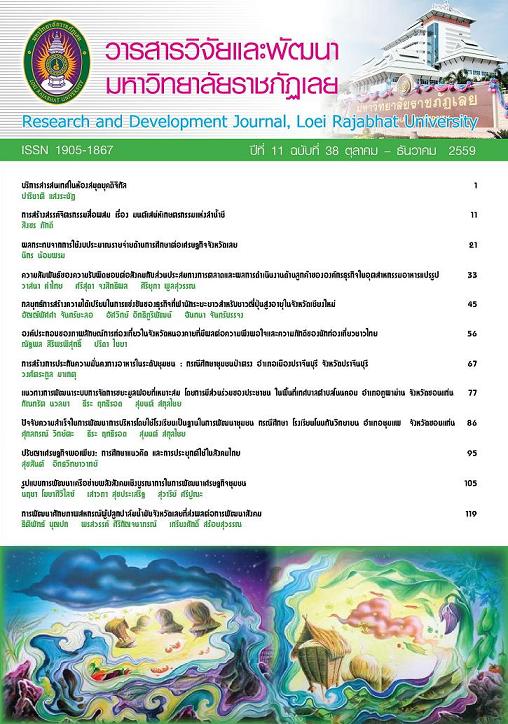แนวทางการพัฒนาระบบการจัดการขยะมูลฝอยที่เหมาะสม โดยการมีส่วนร่วม ของประชาชนในพื้นที่เทศบาลตำบลโนนคอม อำเภอภูผาม่าน จังหวัดขอนแก่น
Keywords:
การพัฒนาการจัดการขยะมูลฝอย, การมีส่วนร่วมของประชาชน, solid waste management, citizen participationAbstract
บทคัดย่อ
รายงานฉบับนี้ มีวัตถุประสงค์เพื่อ 1) เพื่อศึกษาและวิเคราะห์สภาพปัญหาของระบบการจัดการขยะมูลฝอยของเทศบาลตำบลโนนคอม 2) เพื่อเสนอแนะแนวทางการบริหารจัดการขยะมูลฝอยโดยการมีส่วนร่วมของประชาชนในการจัดการขยะมูลฝอยในเขตเทศบาลตำบลโนนคอม โดยผู้ศึกษาได้กำหนดขอบเขตประชากรศึกษา ประกอบด้วย คณะผู้บริหารหัวส่วนราชการ สมาชิกสภาเทศบาลตำบลโนนคอม ประชาชน จำนวน 48 คน การศึกษาข้อมูลในการวิจัยเชิงคุณภาพ (Qualitative research) ตามขั้นตอนการศึกษาวิจัย ด้วยวิธีการสัมภาษณ์เชิงลึก และการสนทนากลุ่ม แล้วนำมาวิเคราะห์หาข้อสรุปตามเป้าหมายต่อไป และนำเสนอในลักษณะพรรณนาความ (Descriptive research)
ผลการศึกษาพบว่า ปัญหาของระบบการบริหารจัดการขยะของเทศบาลตำบลโนนคอม เทศบาลดำเนินการจัดเก็บขยะมูลฝอยในเขตเทศบาลโดยการจ้างเหมาให้บุคคลภายนอกดำเนินการจัดเก็บขยะ ขนส่งขยะไปทิ้งบริเวณที่สาธารณะประโยชน์โนนประดู่ จากการศึกษายังพบว่าวิธีการจัดการขยะมูลฝอยในเขตเทศบาลตำบลโนนคอมที่ยังไม่ถูกหลักสุขาภิบาลมีประชาชนบางหลังคาเรือน ไม่ใช้บริการจัดเก็บขยะมูลฝอยจากเทศบาล โดยนำขยะไปกำจัดเองโดยนำไปทิ้งในบริเวณที่สาธารณะและนำขยะไปเผาทำลายเอง เนื่องจากไม่ต้องการเสียค่าใช้จ่ายในการรับบริการจัดเก็บขยะ ส่วนวิธีการกำจัดขยะในบริเวณบ่อกำจัดขยะขาดการบริหารจัดการที่ดีทำให้เกิดปัญหาขยะตกค้าง และไม่มีการดูแลฝังกลบให้ถูกหลักสุขาภิบาล ด้านการเก็บรวบรวมมูลฝอยจุดรวบรวมขยะมูลฝอย และถังรองรับขยะมูลฝอย พบว่ามีถังขยะไม่เพียงพอสำหรับให้ประชาชนคัดแยกขยะเนื่องจากมีถังใบเดียวสำหรับให้บริการประชาชน ประชาชนส่วนใหญ่ต้องการให้เทศบาลเพิ่มถังที่สามารถคัดแยกขยะเปียกกับขยะแห้งได้ และพบว่ามีถังขยะที่ชำรุดเสียหายจำนวนมากซึ่งเกิดจากการเก็บขนขยะเนื่องจากพนักงานเก็บขนขยะโยนถังขยะที่เป็นพลาสติก ด้านการเก็บขน การขนส่งขยะมูลฝอย และขยะตกค้าง พบขยะตกเรี่ยราดบนถนนที่เก็บขนไปกำจัดเนื่องจากรถที่ใช้เก็บขนขยะเป็นรถบรรทุกที่ดัดแปลงมาสำหรับเก็บขนขยะ ด้านการณรงค์สร้างจิตสำนึกในการกำจัดมูลฝอยพบว่าเทศบาลยังไม่มีการรณรงค์ส่งเสริมสร้างจิตสำนึกอย่างจริงจัง ผู้ศึกษาจึงได้เสนอแนะแนวทางการพัฒนาระบบการกำจัดขยะมูลที่เหมาะสมกับเทศบาลตำบลโนนคอม ได้แก่ 1) การเก็บรวบรวมขยะมูลฝอย 2) การกำจัดขยะมูลฝอย 3) การเก็บขนมูลฝอย และ 4) การรณรงค์ปลูกจิตสำนึก โดยเทศบาลควรส่งเสริมส่งเสริมและรณรงค์ให้ประชาชนรู้จักการการคัดแยกขยะ ประกอบด้วย 1) โครงการอบรมการคัดแยกขยะมูลฝอยอย่างครบวงจร 2) โครงการผลิตปุ๋ยหมักชีวภาพจากขยะอินทรีย์ 3) โครงการธนาคารขยะรีไซเคิลในโรงเรียน และ 4) โครงการซาเล้งเมืองสะอาด โดยให้ประชาชนคัดแยกขยะมูลฝอยก่อนทิ้ง เพื่อลดปริมาณขยะมูลฝอยจากแหล่งกำเนิด และนำกลับมาใช้ประโยชน์ใหม่โดยเน้นการคัดแยกขยะจากแหล่งกำเนิดในครัวเรือน เป็นอันดับแรก การพัฒนาระบบการกำจัดขยะมูลฝอยที่ประสิทธิภาพและเหมาะสมที่สุดคือการกำจัดขยะโดยการมีส่วนร่วมของประชาชนในการบริหารจัดการแก้ร่วมแก้ไขปัญหาร่วมกับภาครัฐและเอกชน อันจะนำไปสู่การแก้ไขปัญหาการจัดการขยะได้อย่างยั่งยืน ต่อไป
Abstract
This research has two purposes: 1) to investigate and analyze the problems with waste management in the Municipality of Non Kom Sub-district; and 2) to propose an improved model for waste management in cooperation with residents. The researcher defined the scope of the population to consist of executives of government sections, members of the council of the Municipality of Non Kom Sub-district, and residents – 48 persons in total.
This study involved: 1) investigation of the current model of waste management with the cooperation of residents in the area of Municipality of Non Kom Sub-district; and 2) the proposal of a model of waste segregation so as to recycle the reusable waste for optimum benefit. The study employed qualitative research methodology in that the research tools comprise collection of data from documents, in-depth interviews and focus groups. Analysis of the data indicates that the municipality manages waste in the area by outsourcing a company to collect and transport the waste to Non Pradoo Public Land. It was also found that the waste management in the Municipality of Non Kom Sub-district was not sanitary in that some residents do not use the waste management service of the municipality but instead dispose of the waste by dumping on public land and burning it in order to avoid paying for the waste management service. In addition, waste management in the land-fill area lacks proper management, so that some waste remains; there is no sanitary landfill process. The research also identified problems with waste collection. There are not enough containers for residents to separate different kinds of waste since only one container is provided. Most residents require more containers from the municipality so they can separate wet and solid wastes. It was also found that many plastic waste containers have been damaged after being thrown by waste collection workers. The process of collecting and transporting the waste leaves waste scattered along the street to the waste disposal site because the transportation vehicle (a truck adapted for waste collection) is not fully adequate. No serious campaign to improve waste disposal had been undertaken. A model is therefore proposed for the development of appropriate waste management for the Municipality of Non Kom Sub-district. The model comprises 1) waste collection, 2) waste disposal, 3) waste transportation, and 4) a campaign to support the realization of the model. The model requires the municipality to support and promote projects so that the residents learn how to separate wastes, namely: 1) The Comprehensive Waste Segregation Training Project; 2) The Bio-fertilizer Production from Bio-wastes Project; 3) The Project to Promote Waste Segregation at School; 4) The Project to Clean the City with Saleng (motorcyles with sidecars for carrying freight); 5) The Tod Pha Pha (Buddhist donation ritual) for Recyclable Wastes Project; and 6) The Recycling Market Project (which involves residents separating their wastes before dumping them to reduce the amount of the waste at the source and to facilitate recycling). It is concluded that most effective and appropriate method to develop the waste management system is to encourage cooperation between residents, government, and the private sector in managing and solving the problem to ensure sustainable waste management.
Downloads
How to Cite
Issue
Section
License
ข้อความที่ปรากฎในวารสารฉบับนี้เป็นความคิดเห็นของผู้เขียนแต่ละท่าน สถาบันวิจัยและพัฒนา มหาวิทยาลัยราชภัฏเลย และกองบรรณาธิการ ไม่จำเป็นต้องเห็นด้วยและไม่มีส่วนรับผิดชอบใดๆ
สถาบันวิจัยและพัฒนา มหาวิทยาลัยราชภัฏเลย ขอให้ผู้อ่านอ้างอิงในกรณีที่ท่านคัดลอกเนื้อหาบทความในวารสารฉบับนี้






